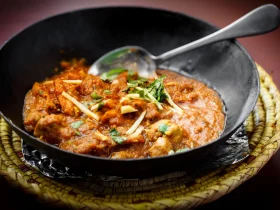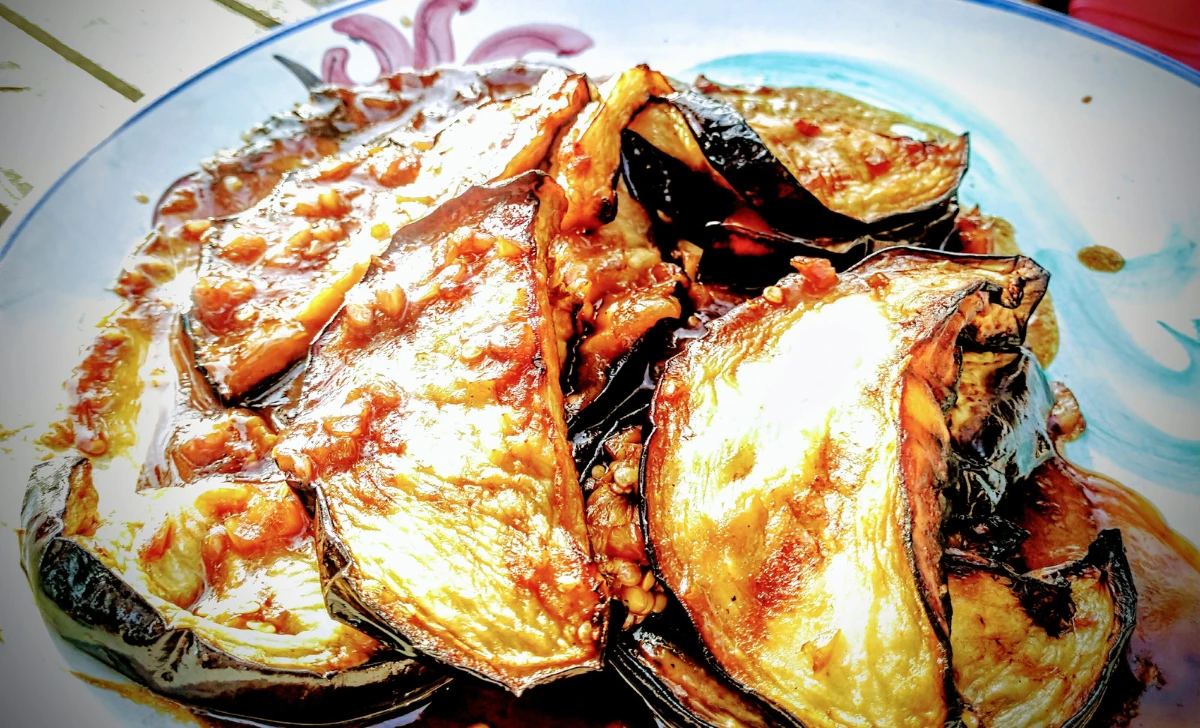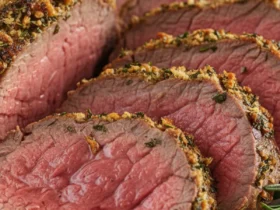Are you ready to embark on a culinary adventure that combines the rich flavors of Szechuan cuisine with the delightful charm of eggplants? Look no further, because this Szechuan Eggplant recipe is here to tantalize your taste buds and add a burst of excitement to your dining table. Whether you’re a seasoned chef or a kitchen newbie, this recipe is designed to be your culinary partner in crime. So, roll up your sleeves, gather your ingredients, and let’s dive into the world of irresistible flavors!
[ez-toc]
History
As we savor the delectable flavors of Szechuan Eggplant, it’s worth taking a step back in time to uncover the rich history and evolution of this mouthwatering dish. From humble beginnings to international kitchens, the story of Szechuan Eggplant is a testament to the fusion of cultures and the artistry of culinary innovation.
Origins in Szechuan Cuisine
The roots of Szechuan Eggplant stretch back to the heart of Sichuan Province in southwestern China. This region is renowned for its vibrant and spicy cuisine, driven by the use of bold flavors and unique ingredients. Szechuan cuisine, characterized by its liberal use of Szechuan peppercorns and fiery chili peppers, is a dance of complex taste profiles that awaken the senses.
A Marriage of Flavors
The union of eggplants and Szechuan spices was a natural progression. Eggplants, known for their ability to absorb flavors like sponges, found themselves in the heart of this fiery cuisine. The creamy, neutral nature of eggplants made them an ideal canvas for the vibrant and intense flavors of Szechuan cuisine.
Innovations in Technique
The technique of searing eggplants before integrating them into the dish was a groundbreaking innovation. This step not only brought out the eggplant’s inherent sweetness but also provided a distinct texture that complemented the boldness of the Szechuan sauce. The art of balance between the neutral eggplant and the assertive sauce was a culinary revelation.
Global Migration and Fusion
As cultures intertwined through migration and trade, so did their culinary traditions. Szechuan Eggplant, once confined to the bustling markets of Sichuan, began its journey across borders and oceans. As it reached new lands, it embraced local ingredients and techniques, resulting in fascinating fusions. From upscale restaurants in New York to street-side stalls in Bangkok, the dish took on diverse interpretations, each a tribute to its roots.
Health and Modern Palates
In an era that celebrates mindful eating, Szechuan Eggplant emerges as a star. Its health benefits, from being low in calories to packing a nutritional punch, resonate with the modern diner. The melding of wholesome ingredients with explosive flavors satisfies both the taste buds and the body’s nutritional needs.
Szechuan Eggplant: A Symbol of Fusion
Today, Szechuan Eggplant stands as a symbol of culinary fusion – a dish that harmoniously brings together the subtlety of eggplants and the exuberance of Szechuan spices. It’s a reminder that culinary traditions are fluid, constantly evolving as they traverse time and space. Whether enjoyed in the heart of Sichuan or on a distant continent, each bite of Szechuan Eggplant is a tribute to the culinary pioneers who dared to push the boundaries of taste.
Time
| Step | Time |
|---|---|
| Prepping the Eggplants | 15 minutes |
| Searing the Eggplants | 10 minutes |
| The Szechuan Sauce Extravaganza | 8 minutes |
| Bringing It All Together | 5 minutes |
Ingredients
| Ingredients | Quantity |
|---|---|
| Fresh Eggplants | 2 medium |
| Szechuan Peppercorns | 1 teaspoon |
| Spicy Red Chili Paste | 2 tablespoons |
| Garlic | 3 cloves |
| Ginger | 1 tablespoon |
| Scallions | 2 |
| Oil (for cooking) | 3 tablespoons |
| Salt | To taste |
| Rice or Noodles (for serving) | 2 servings |
| Wine (for pairing, optional) | As desired |
Please note that the quantities can be adjusted based on personal preferences and taste.
Directions
Prepping the Eggplants
- Wash and Slice: Start by washing the eggplants thoroughly under running water. Cut off the stems and slice them into batons, roughly 2 inches long.
- Salt and Rest: Sprinkle a pinch of salt over the sliced eggplants and place them in a colander. Let them rest for about 15 minutes. This helps reduce bitterness and improves the texture.
Searing the Eggplants
- Heat the Oil: In a large skillet or wok, heat 2 tablespoons of oil over medium heat.
- Sear the Slices: Gently squeeze the eggplant slices to remove excess moisture. Add them to the heated oil and sear them until they turn golden brown on all sides. This should take about 10 minutes. Once done, transfer the seared eggplants to a plate and set them aside.
The Szechuan Sauce Extravaganza
- Infuse the Peppercorns: In the same skillet, add the remaining tablespoon of oil. Add Szechuan peppercorns and let them sizzle for a few seconds until fragrant.
- Add Aromatics: Stir in minced garlic and grated ginger. Allow them to cook for a minute until they release their delightful aroma.
- Introduce Heat: Time to bring in the spicy red chili paste. Add it to the pan and stir well to combine it with the aromatics and peppercorns. Adjust the quantity based on your desired spice level.
Bringing It All Together
- Combine Eggplants and Sauce: Return the seared eggplants to the pan, gently tossing them with the Szechuan sauce. Make sure each slice is coated evenly with the sauce.
- Simmer and Infuse: Let the eggplants simmer in the sauce for about 2-3 minutes. This allows the flavors to meld together beautifully.
Adjusting Spice Levels: A Balancing Act
Spices are your orchestra, and you’re the conductor. To dial the heat up or down, trust your instincts and add chili paste cautiously.
Serving Suggestions: From Rice to Noodles
The stage is set, and it’s time for the grand finale – serving! Scoop your Szechuan Eggplant over steaming white rice or embrace its saucy elegance with silky noodles.
Equipment Required
Nutrition Information
| Nutrition Information | Per Serving |
|---|---|
| Serving Size | 1/2 of recipe |
| Calories | 250 |
| Total Fat | 15g |
| Saturated Fat | 2g |
| Trans Fat | 0g |
| Cholesterol | 0mg |
| Sodium | 600mg |
| Total Carbohydrates | 28g |
| Dietary Fiber | 8g |
| Sugars | 12g |
| Protein | 4g |
| Vitamin D | 0% |
| Calcium | 4% |
| Iron | 6% |
| Potassium | 10% |
| Vitamin A | 30% |
| Vitamin C | 25% |
Please note that these values are approximate and can vary based on the specific ingredients and brands used.
Tips
- Balancing Act: If you’re new to Szechuan cuisine, start with a smaller amount of spicy red chili paste and gradually add more to achieve your preferred spice level.
- Taming Bitterness: Allowing the sliced eggplants to rest with a sprinkle of salt not only reduces bitterness but also enhances their texture.
- Perfect Searing: Achieve that beautiful golden sear on your eggplant slices by ensuring the oil is hot before adding them to the pan. This prevents them from becoming soggy.
- Wok Wonder: While a skillet works fine, using a wok gives you more surface area for even cooking and better sauce distribution.
- Freshness Matters: Opt for fresh, firm eggplants. Their texture and flavor make a significant difference in the final dish.
- Beyond Peppercorns: Experiment with other Szechuan spices like star anise, cloves, and cinnamon for a unique twist.
- Protein Power: Feel free to add protein sources like tofu, shrimp, or chicken to make it a complete meal.
- Noodle Upgrade: Swap traditional rice with stir-fried noodles for a change in texture and taste.
- Serving Elegance: Garnish with chopped cilantro, toasted sesame seeds, or crushed peanuts for an added layer of visual appeal and flavor.
- Leftover Magic: Turn your leftover Szechuan Eggplant into a mouthwatering sandwich filling, a pizza topping, or even a quesadilla stuffing.
- Wine Wizardry: If wine isn’t your preference, pair the dish with a refreshing iced tea or a citrus-infused sparkling water.
- DIY Spice Blend: Create your own Szechuan spice blend by toasting Szechuan peppercorns, chili flakes, and other spices, then grinding them together.
- Texture Play: Enhance the dish’s texture by adding cashews, water chestnuts, or bell peppers for crunch.
- Veggie Delight: Experiment with other vegetables like zucchini, bell peppers, or mushrooms to create your personalized version.
Pros & Cons
| Pros | Cons |
|---|---|
| ✔️ Burst of Szechuan Flavors | ❌ Requires Some Special Ingredients |
| ✔️ Versatile for Vegetarians & Vegans | ❌ Spiciness Might Not Suit Everyone |
| ✔️ Nutrient-Rich with Fiber | ❌ Bitterness of Eggplants for Some |
| ✔️ Easily Customizable | ❌ Longer Prep Time for Best Results |
| ✔️ Fusion of Bold & Balanced Flavors | ❌ High Spice Levels Can Overpower |
Conclusion
As we bid adieu to this flavorful journey through the world of Szechuan Eggplant, we hope you’re feeling inspired and eager to embark on a culinary adventure of your own. This recipe isn’t just about combining ingredients; it’s about creating a symphony of tastes that dance on your palate. From the first sizzle of the eggplant to the aromatic embrace of the Szechuan sauce, each step is a celebration of flavors, cultures, and the joy of cooking.
Imagine the satisfaction of biting into a perfectly seared slice of eggplant, enveloped in the warmth of Szechuan spices. Picture the delight on the faces of your loved ones as they experience the harmonious blend of boldness and balance in each mouthful. With every stir and toss, you’re not just preparing a dish – you’re crafting an experience that brings people together.
So, whether you’re an adventurous foodie or a novice in the kitchen, we encourage you to don your apron, gather your ingredients, and let the magic unfold. Embrace the tips, infuse your creativity, and make this recipe your own. Let the aromas of Szechuan peppercorns and the umami richness of eggplants transport you to a world of culinary enchantment.
As you take that first, eagerly anticipated bite, remember that you’re not just tasting a recipe; you’re savoring the culmination of history, innovation, and your own culinary prowess. So go ahead, ignite your stovetop, let the flavors simmer, and create a memorable meal that’s sure to leave your taste buds tingling and your heart content. Your Szechuan Eggplant journey awaits – let the adventure begin!
Facts
- 🌶️ Fact 1: The Fiery Peppercorn Dance 🌶️
- Did you know that Szechuan peppercorns don’t just bring the heat, but also a surprising tingly sensation? These little flavor ninjas create a playful numbing effect that awakens your taste buds like a culinary roller coaster!
- 🎨 Fact 2: Eggplants – The Versatile Artists of the Plate 🎨
- Eggplants are like the blank canvas of the culinary world. They’re known for absorbing flavors like sponges, letting you paint a masterpiece of taste with every ingredient you choose. A little bit of Szechuan magic, and you’ve got a savory symphony!
- 🍆 Fact 3: Bitter Beginnings, Flavorful Transformation 🍆
- Eggplants were once considered bitter and inedible. But with a sprinkle of salt and a dash of cooking magic, they transform into silky, savory wonders that even the most discerning palate can’t resist. Who knew a little patience could make such a difference?
- 🌍 Fact 4: From Sichuan to Global Plates 🌍
- What started as a regional delight in Sichuan Province, China, has now become a global sensation. From street-side stalls to fancy restaurants, the Szechuan Eggplant’s flavorful journey is a testament to the power of sharing culture through food. It’s like a taste passport for your palate!
- 🕰️ Fact 5: The Evolution of Spicy Time Travel 🕰️
- Szechuan cuisine dates back over 4,000 years, but its flavors are anything but stuck in the past. The Szechuan Eggplant recipe beautifully blends tradition with modern tastes, inviting you to experience history with a contemporary twist. It’s like taking a delicious journey through time!
FAQ’s
Is Szechuan cuisine always extremely spicy?
Szechuan cuisine is known for its bold use of spices, including heat. However, you can adjust the spice level in this recipe to match your preference.
Can I use a different type of eggplant for this recipe?
Absolutely! While purple eggplants are traditional, you can experiment with white or Thai eggplants for a unique twist in flavor and texture.
Where can I find Szechuan peppercorns?
Szechuan peppercorns are available at Asian grocery stores or online spice retailers. Opt for whole peppercorns for maximum flavor.
How can I reduce the bitterness of eggplants?
Sprinkle a pinch of salt on the sliced eggplants and let them rest for about 15 minutes before cooking. This step helps to reduce bitterness and improve texture.
What can I substitute for spicy red chili paste if I prefer less heat?
For milder heat, you can substitute with a tomato-based chili sauce or even gochujang, a Korean chili paste, to maintain a delicious flavor profile.
Can I make this dish ahead of time?
Absolutely! The flavors tend to deepen if allowed to sit. Reheat gently when you’re ready to enjoy it again, and savor the enhanced taste.
Is there a suitable wine pairing for this dish?
A crisp Riesling or a fruity Pinot Noir can beautifully complement the flavors of the Szechuan Eggplant, enhancing your dining experience.
How do I adjust the spice level to my liking?
The amount of spicy red chili paste you use determines the heat level. Start with a small quantity, taste, and gradually add more until it suits your palate.
Can I add protein to this recipe to make it a complete meal?
Absolutely! Feel free to add diced tofu, succulent shrimp, or even sliced chicken to make the dish more substantial and satisfying.
Can I freeze the leftovers for later use?
While it’s best to enjoy the Szechuan Eggplant fresh, you can freeze leftovers in an airtight container. However, keep in mind that the texture may slightly change upon thawing and reheating.












Leave a Review